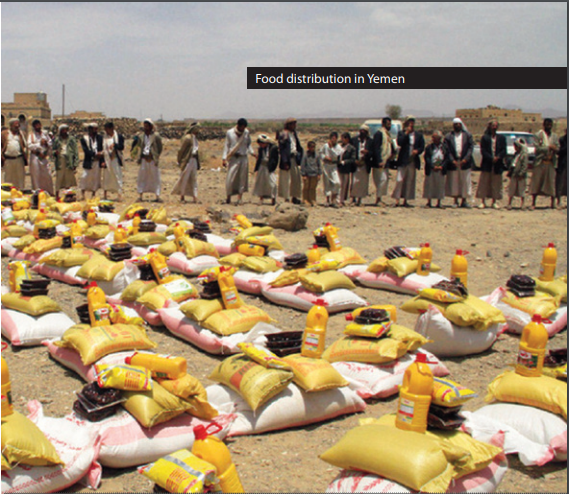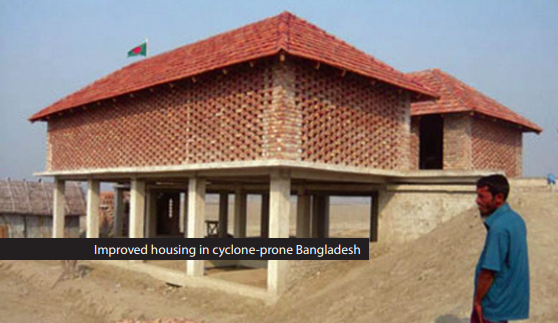
There is a pressing need to address climate change and disaster relief in impoverished countries. The impact of natural disasters can be resolute and destructive, and a sustainable flow of funds is expedient for communities to protect themselves. Development economist Dr Mohammed Kroessin explores how Islamic financial tools can help reduce the vulnerability of the poor to external shocks.
With news of floods, tsunamis, earthquakes, cyclones and many other catastrophic events often dominating our television nowadays, it appears that the incidence and impact of natural disasters has risen dramatically over the last few decades. A combination of population growth and climate change has put additional pressure on resources and created new hazards that traditional mechanisms cannot cope with. New ideas and initiatives are needed in just about every sector of development to reduce the hazards that disasters pose for the poor. Can inclusive finance tools, particularly those inspired by the Shari’a, be a powerful addition to the approaches currently taken by mainstream development actors to reduce the vulnerability of poor people to external shocks?
From disaster response to DRR
Disaster Risk Reduction (DRR) is a systematic approach to identifying, assessing and reducing the risks of disaster. Most commonly it is defined as, “the conceptual framework of elements considered with the possibilities to minimize vulnerabilities and disaster risks throughout a society, to avoid (prevention) or to limit (mitigation and preparedness) the adverse impacts of hazards, within the broad context of sustainable development.” (UN Development Programme website) DRR aims to reduce the socio-economic vulnerabilities of people to disasters as well as dealing with environmental uncertainty and other hazards that trigger them. It is seen in mainstream development discourse as a core responsibility of state and non-governmental development and relief agencies alike, and it should be integral to the way such organisations do their work- not simply an add-on or one-off action. Therefore, DRR has to be very wide-ranging. Its scope is much broader and deeper than conventional emergency management.
In this way, for example, crop insurance provides a risk mitigation mechanism for the poor, who are, due to their very narrow capital and asset base, highly vulnerable to external shocks. In India, a multi-peril crop insurance plan called National Agriculture Insurance Scheme (NAIS) is offered by a government-owned company. The scheme is compulsory for all farmers who take agricultural loans from financial institutions. It is voluntary for all other farmers. The premium is subsidized by the government for farmers who own less than two hectares of land, which makes them both highly vulnerable and also often least able to afford the premium.
Investigating the link between DRR and Islamic finance
The broad scope of DRR is not just limited to reducing the
vulnerability of communities by putting mitigation strategies in place, but can also proactively seek to build economic resilience. Of particular relevance is building their resilience through the diversification of their means of income, which enables poor people to build a more sustainable asset base and, more importantly, savings that can be used in emergencies. Such a pro-active DRR intervention can be financed through revolving capital inputs, provided to the community in the form of murabaha (sales with deferred payment particularly suitable to asset-buildinginterventions focusing on livestock, fertilizer or drought-resistant seeds), mudaraba (investment in irrigation or climate change adaptation technology), musharaka (business partnerships to support agricultural cooperatives or for housing finance, constructing more flood, cyclone, etc. resistant buildings) or ijara (leasing of capital intensive productive assets such as drilling rigs for deep boreholes). Additionally, as the example of India’s National Agriculture Insurance Scheme shows, takaful can play an important role in protecting farmers.
Profit and loss-sharing modes that avoid debt would be preferable for poor clients in disaster-prone areas. This, however, might not be welcomed by Islamic financial intermediaries who are already over-relying on murabaha in order to limit not just moral hazard but also credit risk.

Moreover, the challenge of natural disasters might affect very large segments of the economy and society, as was the case with the major flooding that engulfed Bangladesh in 1998, leading to mass defaults of Grameen
Bank borrowers. It nearly bankrupted the organisation. Therefore, Islamic financial intermediaries need to factor DDR into their reserve and debt rescheduling policies and diversify their portfolios, both in order to fulfil their social mission of financial inclusion and mitigate against financial fragility. This also underlines the need to introduce a mandatory insurance element to safeguard against mass defaults as a consequence of large-scale disasters.
Islamic microfinance and DRR: potential field approaches in Pakistan
The majority of poor people in Pakistan are involved in agricultural activities including livestock herding, rearing and farming. Azad Jammu & Kashmir is a particularly disaster-prone area, as witnessed in the October 2005 earthquake.
Traditionally, women in rural Pakistan are in charge of handling and raising the livestock of the household. Poor livestock entrepreneurs in rural areas remain vulnerable and face drastic negative shocks in the advent of a disaster. Their ability to cope with and cushion against the impact of a disaster remains limited due to the following reasons:
- Limited livestock assets in terms of quantity and quality.
- High dependency on middlemen and inaccessibility to market.
- Lack of skills resulting in inefficient and sub-optimal husbandry techniques.
- Lack of access to financial services resulting in inability to access better quality animals and feed.
- Market fragmentation resulting in low bargaining power.
Whilst this makes them particularly vulnerable to natural disasters, the rural poor of this region can also use their livestock as a method of safeguarding against the negative financial shock of a major disaster, for example, through improved animal husbandry techniques.

Microfinance is one of the few poverty alleviation tools where the disbursing institution can become self-sufficient through its operational activities. This model takes into account the need for becoming sustainable in order to increase the impact on its beneficiaries. Following the mudaraba principle, a profit-sharing arrangement can be utilized to create a joint venture between the Islamic financial institution and each beneficiary, allowing them to develop their livestock in a sustainable manner, and to use more reliable breeding techniques, improved feeds and veterinary care for their livestock.
Financing climate change adaptation in Yemen
The chronic vulnerability of poor people in Yemen is worsened by the impact of the growing global food crisis, fuel crisis, and global financial crisis. This has significantly contributed to increased levels of poverty and food insecurity in the country. Moreover, erratic rainfall patterns, causing droughts as well as devastating floods, have led to crop losses, high livestock mortality and distressed selling of animals, a main productive and life-sustaining asset for farmers in Yemen. The major impact channels of climate change in Yemen are through changing food prices, long-term local yield changes as a result of temperature and rainfall variations, and damages and losses of cropland, fruit trees, livestock, and infrastructure as a result of natural disasters such as recurrent floods and landslides. Disaster risk management and social protection policies are therefore crucial to improving Yemen’s resilience in the face of climate change.
Various research studies recommend that Yemen should adopt and include an action plan for improving food security, combined with better integration of climate change policies in national development strategies, and agricultural and rural policies. With Yemen only occasionally being in the international limelight, questions marks about the development financing model remain.
Unemployment is fairly broad, cutting across urban and rural areas and was much exacerbated by the recent political unrest. According to the preliminary results of the UN World Food Programme’s Comprehensive Food Insecurity Survey, approximately 10 million of the population is food ‘insecure’. Agriculture is of vital importance in Yemen. Over 70 percent of its people rely on crop and livestock production to earn a living and to meet their basic food needs. Years of man-made and natural disasters have meant many are no longer effectively able to do so. In Yemen, the agriculture sector is under considerable strain. Heavy reliance on imported food items has made Yemen extremely vulnerable to soaring costs as a result of global price increases. Hunger could grow worse unless emergency agricultural assistance, microfinance support, livelihood intervention and related disaster risk reduction measures reach those most in need.
At the same time, both the volatility of the financial markets and the accompanying soaring global food prices have already led to considerable investment in industrial-scale agriculture in developing economies. Despite previous agricultural practices being primarily subsistence-focused, this efficiency increase is not without criticism as, when multinationals move in, it often leads to land expropriation of tenant farmers, who have no legal rights to the fields that have been ploughed by generation after generation.
Inclusive finance providers, including Islamic financial intermediaries, could support small farmers through mudarabah or salam (forward purchase) facilities encouraging investment, increased efficiency and re-engagement in agriculture, animal husbandry and fisheries by rehabilitating farming land, culverts, storage facilities, rearing hybrid breeds with higher milk or meat yields, purchasing drought-tolerant seeds to minimize crop failure, and securing their next cropping season. This needs to go hand-in-hand with the promotion of capacity building by training farmers in improved soil and water management practices, food preservation and processing, and training local agriculture extension and veterinary staff in disease surveillance and treatment by targeting farmers at risk. Altogether it will contribute to lessening the food insecurity in Yemen.
Such a programme can enhance sustainable livelihoods and improve drought, flood and disease resilience through enhanced water resources development, management and availability for domestic, livestock, agricultural and fisheries sectors; improved livestock infrastructure for market access; improved management of rangelands to enhance forage availability in a sustainably managed environment, and improved livestock health. The programme has to build human and institutional capacities to move higher on the water and livestock value chains. Policy, legal and institutional environments need to be enhanced for improved water management and livestock systems in order to contribute to disaster risk reduction and, in turn, to generate improved and sustainable economic and social well-being.
The future of DRR
Given the broad scope of DRR, there is considerable potential for initiatives such as those illustrated above to incorporate Islamic microfinance approaches that are aiming to reduce poor people’s socioeconomic vulnerabilities to disaster.
Moreover, due to the participatory nature of profit and loss sharing financing products and takaful, the integration of Islamic finance into DRR programmes can enhance sustainable livelihoods and therefore make poor and vulnerable people more resilient to the ever-growing challenge of climate change and natural disasters.



